Superman Comic Books
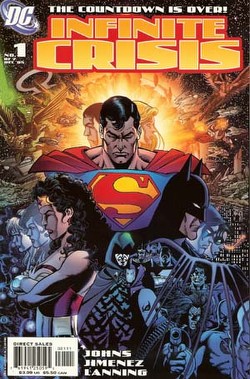
Superman: Special Reports
Infinite Crisis Primer
Author: Sean HoganLast updated: November 8, 2005
The Infinite Crisis miniseries is arguably DC's biggest comic event in 20 years. While writer, Geoff Johns, promises that you will learn everything you need to know in the first two issues of Infinite Crisis, it builds on a long and sometimes complicated history of the DC Universe.
This Primer helps to bring you up to date on that history so that you can fully appreciate Infinite Crisis.
In the Beginning...
The superhero comics era began with the introduction of Superman in Action Comics #1, published in 1938. Superman was followed shortly by Batman in Detective Comics #27 and the success of those two characters spawned an explosion of costumed heroes and villains.The development of Superman, Batman and others was not planned and plotted, but haphazardly arose according to the whims of the writers and the dictates of the story. Over time, Superman acquired foster-parents, a birth planet, and increasing powers. Initially leaping tall buildings, he was later able to fly. He acquired heat vision, x-ray vision, super-cold breath and even, for one issue, super-putty-face-changing ability. Superman became so popular, the publisher created a youthful version - the mighty Superboy - even though earlier stories had him beginning his career as an adult.
Initially, these superheroes kept to themselves. As their popularity became apparent, they began to meet and their individual worlds merged. The Justice Society of America first appeared in the Winter 1940 edition of All-Star Comics #3. The comic initially had the characters meet and discuss their individual adventures and only in later issues had them actually team up for adventures together.
Although Superman and Batman were seen together on the covers of World's Finest Comics, aside from brief meetings in All-Star Comics #7 in 1941 and #36 in 1947, they didn't share an adventure together until June 1952 when they met on a cruise ship in Superman #76. They began regularly appearing together as of World's Finest Comics #71 in the summer of 1954.
The Resurgence
While comic sales remained fairly healthy after World War II, the interest in superhero comics declined while other genres gained popularity - including romance, comic animals, westerns, mystery, science fiction and war stories.Superman, Batman and Wonder Woman continued on a regular basis, but their colleagues faded from print and memory. Then in 1956, the superheroes returned, beginning with the introduction of the Flash in Showcase #4 and soon followed by Green Lantern and others. While using the same heroic names of the previous versions of the characters, these were entirely new heroes, with different costumes, identities, and supporting casts. In only four years, there were enough new characters to star in an updated version of the Justice Society of America - this time called the Justice League of America.
Parallel Worlds in Crisis
In September 1961, The Flash #123 had the newest Flash, Barry Allen, vibrate across dimensions to a parallel Earth where he met the original Flash, Jay Garrick. In a later adventure, Jay introduced Barry to his pals in the Justice Society and then in August 1963, the JSA met the JLA in Justice League of America #21 and 22.The JSA heroes were counterparts of the modern heroes and roughly twenty years older since, on their Earth, the heroic age started at the dawn of World War II. Since the current versions were the then-published characters, the JLA's Earth became known as Earth-One, while the JSA were from Earth-Two.
This two part JLA story, entitled "Crisis on Earth-One", set the stage for annual summer meetings of the Justice League and the Justice Society. The later stories often took their cue from the original, using the word "Crisis" as part of the story title and usually taking members from both teams to other Earths.
Over the next 30 years, readers were introduced to Earth-Three (home of the villainous Crime Syndicate of America), Earth X (home of Uncle Sam and the Freedom Fighters on a world where the Nazis won WWII) and Earth S (home of Captain Marvel and the Shazam! family of heroes).
Beginning in 2002, DC began issuing trade paperbacks collecting these adventures using the name, "Crisis On Multiple Earths". As of 2005 there are three volumes collecting every meeting up to 1974. These volumes contain classic and fun stories and are a great introduction to the characters featured in Infinite Crisis
Crisis On Infinite Earths
In 1985, DC embarked on a massive restructuring of its universe with the 12 issue maxiseries by Marv Wolfman and George Pérez, with the goal of merging all of the various Earths into one. The story lived up to its tag line: "Worlds will live. Worlds will die. And the universe will never be the same."The villain of the story is the Anti-Monitor, a being born in the anti-matter universe - the dark twin to our positive matter universe. By destroying universe after universe, he creates an imbalance that increases his power. Opposing him is the Monitor, who gathers heroes from different universes in an attempt to thwart the Anti-Monitor.
In addition to the Monitor and his anti-matter twin, new characters are introduced to readers:
Harbinger is the Monitor's aide - rescued as a child, she has the power to divide herself into multiple bodies to recruit heroes.
Pariah is a man who is cursed to appear as the worlds die, able only to witness their destruction.
Alexander Luthor is a child born on the evil Earth-Three and is the son of that world's hero, Lex Luthor, and his wife, Lois Lane. Alexander's body contains both matter and anti-matter and he quickly grows from an infant into a young man, able to create a passage between the two universes.
Superboy is Clark Kent, from a world known as Earth Prime (supposedly the "real" Earth where there are no superheroes).
Many worlds died - one of the earliest being Earth-3. Many heroes fall and die - the most notable being Barry Allen (the Flash who both sparked the new age of superhero comics and introduced us to the Justice Society and Earth-Two) and Superman's cousin, Supergirl.
Towards the end, five worlds remained: Earth-One (home of the Justice League), Earth-Two (home of the Justice Society), Earth-S (home of Captain Marvel and family), Earth-C (home of characters DC acquired shortly before from Charlton Comics - including Blue Beetle and Captain Atom) and Earth-X (home of Uncle Sam and the Freedom Fighters).
After a battle at the beginning of time between the Anti-Monitor and the Spectre (a cosmic being who is a member of the JSA), the five worlds were merged imperfectly into one. On this new world, the only people who remember the multiverse are those who witnessed the battle at the beginning of time.
A final battle ensues against the Anti-Monitor and the villain is at last defeated, but at great cost. While most of the heroes who survive return to Earth, four remain trapped in the dying anti-matter universe - Superboy of Earth-Prime, Superman and Lois of Earth-Two and Alexander Luthor of Earth-Three. Alexander provides a bittersweet ending for them as he opens a portal to another place - a beautiful place where "there will be no fear ... only peace ... everlasting peace."
While Crisis on Infinite Earths may not be required reading for Infinite Crisis, it will certainly expand your understanding of the story (and explain why so many long time readers cheered madly at the end of Infinite Crisis #1), but it is a terrific story in and of itself and highly recommended.
For 14 years, the only way to read Crisis on Infinite Earths was to buy the original issues at expensive prices from comic shops. In 2000, DC released a trade paperback collection of the 12 issues with new colouring by Tom Peyer and better paper for a clear, clean and beautiful collection. DC has now published the Ultimate Collection version in hardcover with an accompanying companion book.
Crisis on Infinite Earth showcases a huge array of heroes and villains, allowing you to enjoy the main story and characters while being impressed and intrigued by the diversity and richness of the DC multiverse.
Marv Wolfman and George Pérez followed Crisis with a two volume History of the DC Universe, which has also been released in a collected volume. This story was intended to set out the history of the new unified universe, but it quickly became apparent that DC's new continuity had some serious problems.
Crisis Fallout
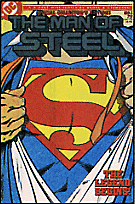 Following the Crisis maxiseries, DC decided to make a fresh start on Superman, Wonder Woman and Hawkman, among others.
Following the Crisis maxiseries, DC decided to make a fresh start on Superman, Wonder Woman and Hawkman, among others.Superman's origin was revised and re-told by John Byrne in Superman: The Man Of Steel, a six issue miniseries. There were several changes from the previous origin story, the most significant of which was that Superman began his career as an adult - which meant that he never had a career as Superboy. Another significant decision was to make Superman the sole survivor of Krypton - most notably eliminating Supergirl from ever having existed.
This decision removed a fundamental underpinning of the Legion of Super-Heroes - DC's tales of young super-heroes set 1,000 years in the future who not only modelled themselves after Superboy, and also had him, and Supergirl, as time-travelling members.
Wonder Woman's origin was retold by George Pérez who gave her a richer, deeper origin but had her arriving after the formation of the Justice League. This removed her status as a founding member and failed to explain how Donna Troy - Wonder Girl of the Teen Titans - could exist before the arrival of the woman who was her mentor and inspiration.
Hawkman was completely re-imagined by Tim Truman in Hawkworld, but with the origin set in the present day and therefore invalidating previous Hawkman history.
By moving the origins of Superman, Wonder Woman, Hawkman and Batman to the present day, DC removed them from their connections with the Justice Society. This created havoc with series that focused on the JSA, such as Roy Thomas' wonderful All Star Squadron stories about the JSA and other superheroes, set during World War II.
Other problems arose because of characters that remained, even when their origins no longer applied. Power Girl, who was originally the cousin of Superman from Earth-Two, continued to exist in the new DC Universe, even though her cousin did not and even though the modern Superman no longer had any Kryptonian relatives.
Over time this led to a number of revisions and retcons which attempted to "fix" these problems. Some of these had the Legion's Superboy coming from a pocket universe, having the previous Hawkman revealed as a traitor, replacing Wonder Woman with Black Canary in the origin of the Justice League and making Power Girl the granddaughter of Arion of Atlantis. As these retcons were criticized, subsequent stories became even more convoluted - particularly for characters such as Hawkman and Donna Troy. The Legion, after several revisions, was completely rebooted to start again.
Some wonderful stories arose both from the new origins as well as from the "fixes", but it was a far cry from the clean unification anticipated by Crisis on Infinite Earths.
And how can you explain the Crisis itself when no one is supposed to remember the multiverse? In the post-Crisis universe, stories have referred to a great Crisis, but are vague as to what happened, except that the Flash (Barry Allen) died as a result.
The only series to explore the post-Crisis fallout in any kind of detail was in Grant Morrison's run on Animal Man (from issue 1 to 26). The main Crisis storyline begins in issue 22 when we meet the Psycho Pirate, who is apparently the only person to remember the entire Crisis and the pre-Crisis universes and who is able to re-create the multiverse of characters. It's a weird and fun story that has Animal Man eventually meeting his writer, Grant Morrison and realizing that he is a fictional character.
Prelude to Infinite Crisis
Planning and plotting for the Infinite Crisis miniseries apparently began at least two years before the first issue arrived in September 2005.Strange and unexplained events began to take place throughout the DC Universe. One of the first may have been the sudden change to Superboy's origin in Teen Titans #1, dated September 2003 when he learned that he was cloned with an equal donation from Superman and Lex Luthor.
Superboy's origin up to that point was that he had been cloned from Cadmus director, Paul Westfield, with genetic modifications that give him powers emulating Superman's. The origin change was made by Geoff Johns, who is also the writer of Infinite Crisis.
Begin Pet Peeve & Pet Theory Time: what most annoys me about this change is that it undermines many of Superboy's previous stories by Karl Kesel in the Superboy comic. That plus I've done an article on Superboy that can be tossed out if "everything you thought you knew was wrong". So here's how I reconcile it (Mr. Johns, please feel free to adopt this theory if you haven't already thought of it yourself):
In the story arc, "Hypertension", in Superboy #60-64 (with an epilogue in #65), Superboy is catapulted into Hypertime (a multiverse equivalent of alternate realities introduced in the 1999 Mark Waid written specials, The Kingdom). Over the course of the story arc, Superboy meets alternate versions of himself and, during a battle, all versions of Paul Westfield are accidentally deleted from existence. Since neither Westfield nor his alternate versions ever existed, the universe rewrote itself to make Superman and Lex the genetic parents of Superboy. End Pet Theory Time.
Anyway, back to our story.
Other significant changes began occurring around the DC universe. The biggest surprise was probably the reappearance of the formerly dead Jason Todd (the second Robin after Dick Grayson resigned), who suddenly and inexplicably returned healthy and hearty, but disguised as the Red Hood.
Crisis Management
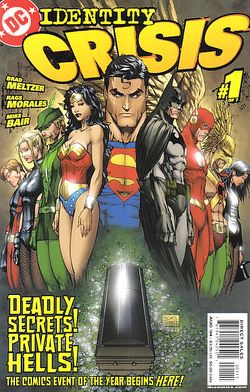 Things began picking up steam in a more obvious manner with the 7 issue Identity Crisis in 2004, written by Brad Meltzer with art by Rags Morales and Mike Bair. This controversial miniseries was framed as a murder mystery surrounding the death of Sue Dibny, wife of the formerly fun Elongated Man, Ralph Dibny. While the resolution was (in my opinion) disappointing, the story created a high profile for DC and shook up the status quo.
Things began picking up steam in a more obvious manner with the 7 issue Identity Crisis in 2004, written by Brad Meltzer with art by Rags Morales and Mike Bair. This controversial miniseries was framed as a murder mystery surrounding the death of Sue Dibny, wife of the formerly fun Elongated Man, Ralph Dibny. While the resolution was (in my opinion) disappointing, the story created a high profile for DC and shook up the status quo.The major fallout from Identity Crisis was twofold.
First, it stirred up the criminal elements when they learned that the Justice League had not only erased the criminal's memories (whenever they learned the secret identities or private information about the heroes), but also changed the criminal's personalities - most significantly turning Dr. Light from a dangerous criminal into a lightweight laughable moron.
Second, it created dissension between the heroes both over the mind-wiping and personality alterations of criminals, but also because of a decision to erase Batman's memories of their actions and to keep these actions secret from other League members.
Identity Crisis did not end neatly, and left many loose ends and dangling plot threads that were subequently followed up in various comics.
Crisis Countdown
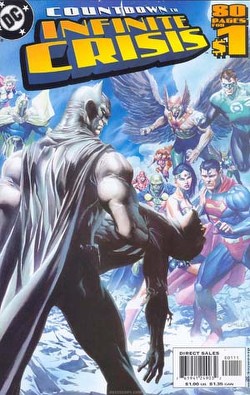 Following the conclusion of Identity Crisis, DC gave the first indication of its larger plans when it published the Countdown to Infinite Crisis, dated May 2005. In that 80 page special, another DC character, Blue Beetle (Ted Kord) was killed after learning of a plot to destroy all metahumans (superheroes and super villains). In a dark twist, the villain behind the plot is revealed to be Max Lord - a Justice League ally who organized the fun and light hearted post-Crisis JLA, which included Blue Beetle and the Elongated Man as members.
Following the conclusion of Identity Crisis, DC gave the first indication of its larger plans when it published the Countdown to Infinite Crisis, dated May 2005. In that 80 page special, another DC character, Blue Beetle (Ted Kord) was killed after learning of a plot to destroy all metahumans (superheroes and super villains). In a dark twist, the villain behind the plot is revealed to be Max Lord - a Justice League ally who organized the fun and light hearted post-Crisis JLA, which included Blue Beetle and the Elongated Man as members.Countdown spun off four miniseries following up on various storylines.
The OMAC Project began exactly where Countdown ended, with Max Lord ordering his underlings to remove Beetle's body. In that miniseries (six issues, with a detour between issues 3 and 4 into the Sacrifice story arc running through the Superman titles and Wonder Woman #219), we learn that Max has taken control of an organization named Checkmate as well as control over a spy satellite developed by Batman, called Brother Eye. Brother Eye controls nano-machines that have infected people around the world and can turn them into OMACs (One Man Army Corps).
Max has also learned to take control of Superman's mind and is using him as a weapon until Wonder Woman decides that the only way to remove that risk is to kill Max Lord. She breaks his neck, but the Brother Eye computer then becomes autonomous and begins a direct assault on superheroes (and villains) through its various OMACs.
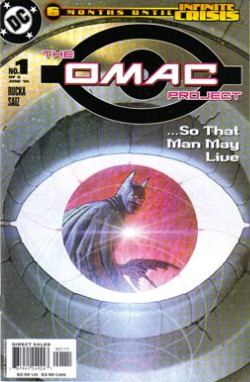 Superman and Wonder Woman have a falling out over Max Lord's murder, with Superman believing that it should never have been done and Wonder Woman believing that it was the only way to prevent Lord from continuing to control Superman. To make matters worse, the Brother Eye computer becomes independent on Lord's death and broadcasts the scene of Wonder Woman snapping Lord's neck on every television around the globe.
Superman and Wonder Woman have a falling out over Max Lord's murder, with Superman believing that it should never have been done and Wonder Woman believing that it was the only way to prevent Lord from continuing to control Superman. To make matters worse, the Brother Eye computer becomes independent on Lord's death and broadcasts the scene of Wonder Woman snapping Lord's neck on every television around the globe.
The other significant event from that miniseries is that Sasha Bordeaux, (former bodyguard and lover to Bruce Wayne/Batman, and a Checkmate agent), is infected with the OMAC nanomachines, but is allowed to remain autonomous.
Batman's actions in creating Brother Eye in secret, and then losing control of it, lead to further divisions between him, Superman and Wonder Woman.
Day of Vengeance is a miniseries that examines the magic users in the DC universe. Two cosmic powers join forces as Eclipso (who formerly served as the Wrath of God) merges with Jean Loring (the murderer from Infinite Crisis) and seduces the current Wrath of God - the Spectre. A group of magic users calling themselves the Shadowpact are able to thwart but not defeat the Eclipso/Spectre team. The final issue has the Spectre apparently destroying the wizard, Shazam, and releasing the demons known as the Seven Deadly Sins.
The Rann/Thanagar War follows from the excellent miniseries, Adam Strange, and deals with an interstellar war. While enjoyable, the relationship to the new Crisis only appears in the sixth and final issue when a white hole, or tear in reality, opens in the midst of the interplanetary war.
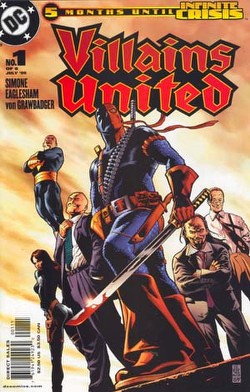 Villains United tells of two opposing criminal forces - the Injustice Society formed by major DC villains, including Lex Luthor, Black Adam, Talia Al Ghul and Deathstroke - and a smaller group known as the Secret Six, who are led by the mysterious Mockingbird. In the sixth and final issue we learn that Mockingbird is really Lex Luthor - but a different Lex from the one who leads the main group of villains. The Mockingbird Lex is the green eyed villain who has been in continuity since the Superman: The Man of Steel miniseries while the blue eyed Lex of the Injustice Society is the alternate Luthor with an unknown origin. The alternate Luthor somehow manages to capture and torture Pariah from Crisis on Infinite Earths - firmly tying that story into the earlier Crisis.
Villains United tells of two opposing criminal forces - the Injustice Society formed by major DC villains, including Lex Luthor, Black Adam, Talia Al Ghul and Deathstroke - and a smaller group known as the Secret Six, who are led by the mysterious Mockingbird. In the sixth and final issue we learn that Mockingbird is really Lex Luthor - but a different Lex from the one who leads the main group of villains. The Mockingbird Lex is the green eyed villain who has been in continuity since the Superman: The Man of Steel miniseries while the blue eyed Lex of the Injustice Society is the alternate Luthor with an unknown origin. The alternate Luthor somehow manages to capture and torture Pariah from Crisis on Infinite Earths - firmly tying that story into the earlier Crisis.
None of these miniseries are apparently required reading for Infinite Crisis and readers have to be warned that none of them have a very satisfactory ending (although Villains United comes closest) as they set up stories to be told in Infinite Crisis.
In addition to the four miniseries springing directly from Countdown, there are three other series of note which tie into Infinite Crisis
The Return of Donna Troy - this four issue miniseries is densely written by Phil Jimenez (artist for Infinite Crisis) and beautifully drawn by Jose Luis Garci-Lopez and George Pérez. Donna Troy's background is complex and I won't go over it here. For the purpose of Infinite Crisis, all you need to know is that in the final issue, it is revealed that Donna's history is long and complicated because she is the merger of many alternate versions of herself - one of which was Dark Angel, who the Anti-Monitor initially intended to use as the Monitor used Harbinger, from Crisis on Infinite Earths. Donna inherits Harbinger's records of the multiverse and learns of some great crisis affecting the future. She begins to recruit an assembly of heroes to join her as she heads into space.
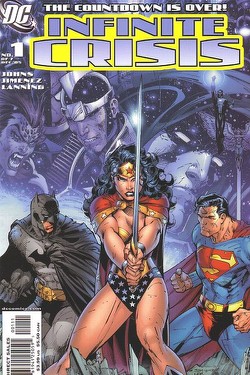 JSA Classified #1 - 4 plays with Power Girl. The first three issues showcase her identity crisis and power fluctuations and tease with alternate explanations for her background. The villain behind these manipulations is the Psycho Pirate who, in the concluding issue, explains her original origin as the cousin of Superman of Earth-Two. All of which leave Power Girl more confused than before, with the reader being advised to follow the story into Infinite Crisis #2.
JSA Classified #1 - 4 plays with Power Girl. The first three issues showcase her identity crisis and power fluctuations and tease with alternate explanations for her background. The villain behind these manipulations is the Psycho Pirate who, in the concluding issue, explains her original origin as the cousin of Superman of Earth-Two. All of which leave Power Girl more confused than before, with the reader being advised to follow the story into Infinite Crisis #2.
JLA #115-119 also provides a direct connection between Identity Crisis and Infinite Crisis as Geoff Johns co-writes "Crisis of Conscience", dealing with the consequences of the mind wiping on both the villains and the heroes. While they defeat the villains, most of the JLA members resign. In an epilogue of sorts, an unknown, red-caped person confronts the Martian Manhunter, and blows up the JLA's moon-based Watchtower.
To further assist readers, DC has also published a 96 page collection of reprints titled Prelude to Infinite Crisis which collected a Superman story, a two part Flash/Wonder Woman story and selected pages from over two dozen comics published in the preceding two years with an explanatory commentary.
If you choose not to read or can't afford all of the above, but want the most direct tie-ins, my recommended reading list is as follows: Countdown to Infinite Crisis, Prelude to Infinite Crisis, the trade paperback collection of The OMAC Project (containing all six issues plus Wonder Woman #219), issues 5 & 6 of Villains United, and the final issue (#6) of Day of Vengeance.
And now, if you have any money left, you can purchase and enjoy Infinite Crisis.
